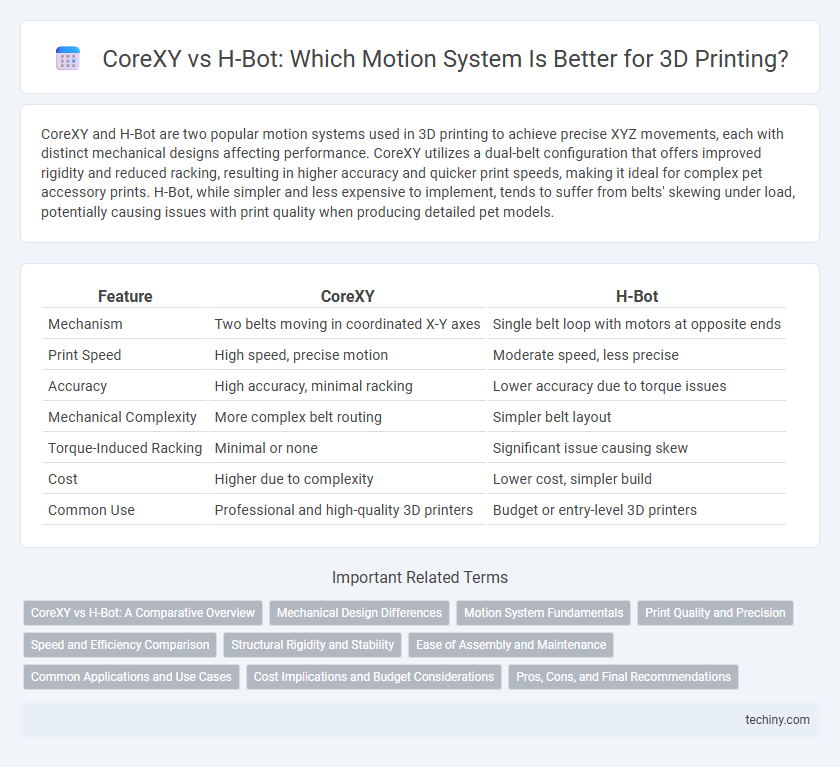CoreXY and H-Bot are two popular motion systems used in 3D printing to achieve precise XYZ movements, each with distinct mechanical designs affecting performance. CoreXY utilizes a dual-belt configuration that offers improved rigidity and reduced racking, resulting in higher accuracy and quicker print speeds, making it ideal for complex pet accessory prints. H-Bot, while simpler and less expensive to implement, tends to suffer from belts' skewing under load, potentially causing issues with print quality when producing detailed pet models.
Table of Comparison
| Feature | CoreXY | H-Bot |
|---|---|---|
| Mechanism | Two belts moving in coordinated X-Y axes | Single belt loop with motors at opposite ends |
| Print Speed | High speed, precise motion | Moderate speed, less precise |
| Accuracy | High accuracy, minimal racking | Lower accuracy due to torque issues |
| Mechanical Complexity | More complex belt routing | Simpler belt layout |
| Torque-Induced Racking | Minimal or none | Significant issue causing skew |
| Cost | Higher due to complexity | Lower cost, simpler build |
| Common Use | Professional and high-quality 3D printers | Budget or entry-level 3D printers |
CoreXY vs H-Bot: A Comparative Overview
CoreXY and H-Bot systems both utilize belt-driven mechanics to achieve multi-axis movement in 3D printers, but CoreXY offers improved rigidity and reduced belt twisting due to its crossed-belt design. This design difference translates to higher precision and faster printing speeds in CoreXY setups compared to the H-Bot's susceptibility to racking forces and belt tension issues. CoreXY's mechanical advantages make it a preferred choice for high-performance 3D printing applications requiring accuracy and consistency.
Mechanical Design Differences
CoreXY employs a fixed motor design with stationary pulleys and a unique belt routing system that results in stable, synchronized motion, minimizing vibrations and improving print quality. In contrast, H-Bot uses a single moving belt driven by two motors on one axis, causing racking forces and potential mechanical inaccuracies due to asymmetric belt tension. The CoreXY's mechanical design offers superior rigidity and precision for complex 3D printing tasks compared to the less stable H-Bot configuration.
Motion System Fundamentals
CoreXY and H-Bot both utilize belt-driven motion systems designed for 3D printers, but CoreXY features a crossed belt arrangement that enhances rigidity and reduces racking forces during simultaneous X and Y movements. H-Bot employs a simpler belt layout with two motors driving a single belt loop, which can introduce torque-induced skewing under certain load conditions. The mechanical differences directly impact print accuracy and speed, making CoreXY favored for high-precision applications due to its stable kinematic geometry.
Print Quality and Precision
CoreXY systems deliver superior print quality and precision due to their rigid, dual-motor design that minimizes frame distortion and backlash. H-Bot mechanisms often suffer from racking issues caused by the single belt loop, leading to reduced accuracy and inconsistent layer alignment. Consequently, CoreXY printers provide more reliable dimensional accuracy and smoother surface finishes in complex 3D prints.
Speed and Efficiency Comparison
CoreXY systems offer superior speed and efficiency compared to H-Bot designs due to their rigid kinematic structure, which minimizes motor-induced racking and maintains better positional accuracy at high velocities. The CoreXY's belt arrangement allows for independent motion of X and Y axes without introducing rotational forces, resulting in faster print speeds and more precise layer alignment. In contrast, H-Bot systems suffer from mechanical stress and unwanted twisting during rapid movements, limiting their maximum effective speed and reducing overall print quality.
Structural Rigidity and Stability
CoreXY systems offer superior structural rigidity and stability due to their fixed motor mounts and reduced moving mass, resulting in more precise and consistent prints. In contrast, H-Bot designs suffer from racking and skewing caused by the long belt paths and cantilevered motors, leading to potential inaccuracies during high-speed printing. The improved mechanical stability of CoreXY makes it a preferred choice for applications demanding higher print quality and repeatability.
Ease of Assembly and Maintenance
CoreXY 3D printers offer a more straightforward assembly process due to their simpler belt routing and fixed motor positions, which also reduces the risk of belt misalignment during maintenance. In contrast, H-Bot designs require meticulous calibration because their single-belt system can introduce racking forces, complicating both setup and ongoing adjustments. Maintenance of CoreXY systems benefits from better mechanical stability and easier access to components, making troubleshooting and part replacements faster and more reliable.
Common Applications and Use Cases
CoreXY and H-Bot mechanisms are widely used in 3D printing for their distinct motion control advantages. CoreXY is commonly favored in desktop 3D printers due to its superior rigidity and accuracy, ideal for detailed prototypes and functional parts. H-Bot finds application in large-format and CNC-style 3D printers, where a simpler belt system supports heavier gantries and moderate-speed printing tasks.
Cost Implications and Budget Considerations
CoreXY 3D printers generally incur higher initial costs due to more complex belt routing and additional components, but they offer superior print quality and speed, which can reduce long-term operational expenses. H-Bot designs tend to be more budget-friendly and simpler to assemble, making them attractive for first-time builders or cost-conscious projects despite potential challenges with mechanical stability and precision. Evaluating CoreXY versus H-Bot should consider not only upfront expenses but also maintenance, calibration time, and print accuracy, all of which impact overall budget efficiency in 3D printing setups.
Pros, Cons, and Final Recommendations
CoreXY offers higher rigidity and reduced moving mass by using a stationary bed and fixed motors, resulting in faster, more precise prints with less vibration. H-Bot systems tend to suffer from racking and decreased accuracy due to the gantry's parallel belt layout, which can cause mechanical stress and misalignment during high-speed movements. For high-performance 3D printing requiring speed and precision, CoreXY is generally recommended, while H-Bot may suit simpler, cost-effective builds with lower accuracy demands.
CoreXY vs H-Bot Infographic

 techiny.com
techiny.com